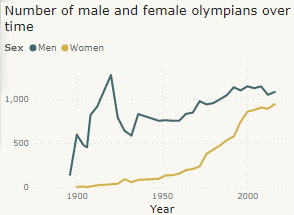The world’s leading sports competition are the Olympic games (1). It is an athletic festival that was invented in ancient Greece and achieved major importance by the end of the 6th century BCE. The Olympics were invigorated in the late 19th century with the modern games being held in 1896 (1). The International Olympic Committee headquartered in Lausanne, Switzerland, direct the Olympic movement and its regulation.
As Tokyo Olympic Games just ended, this review will tackle 120 years history of Modern Olympic Games (1896-2016). Modern Olympic Games are leading international sport events featuring summer and winter sports competitions (2).
Olympic Games were held in many countries including Greece, France, England, and Germany, where many athletes from all around the world have participated to represent and try to bring glory to their countries.
Some of the most played Olympic games are Rowing, Swimming, Football, Fencing, Gymnastics.
What are the dominant countries in Olympic Games?

Fig1: Total number of medals won by each country.
Throughout the time we can see that USA clearly dominates the Olympic Games as they have a total of 5219 Medals with 2474 Gold medals, 1512 Silver medals and 1233 Bronze medals, in what is a clear dominance as they have more than double the count of Medals from their closest rivals which are the Soviet Union, and Germany (1).
How has Participation Changed per gender and season Over time?


Fig2: Participation of women and men over time in each season.
On the left we can see the participants of Winter Olympic Games and on the right the participants of Summer Olympic Games.
As we can see the number of participants in summer games is much higher than in winter games, and how the female participants have increased to nearly catch up with numbers of male participants (3).
Who are the most decorated athletes?

Fig3: Number of medals per athletes , women and men.
The most decorated male player of all time is USA’s one and only Michael Fred Phelps with 23 Gold medals all of them coming from swimming followed by his fellow countryman Raymond Clarence with 10 Gold medals from athletics.
Furthermore, the most decorated female is Soviet Union’s Larisa Latynina with 9 Gold medals (Gymnastics), followed by Germany’s Birgit Fischer-Schmidt who has 8 medals under her belt, and she won while participating in canoeing games (4).
How are medals distributed by sport?

Fig4: Percentage % of medals distribution by sport.
This graph shows us how medals are distributed by sport as we see the sport with most medals being Athletics followed by Swimming, Rowing, Gymnastics and Fencing, and the least being Jeu de Paume, Roque, Basque Pelota and Aeronautics (5).
What is the best weight and height of gold medalists by each sport?

Fig5: Best BMI for each sport of gold medalists.
The sports that require the least average of both weight and height are: Synchronized swimming, CrossFit, and Rhythmic gymnastics. Whereas the sports that require the highest average are Rugby, Basketball, Rowing and Volleyball (6).
In conclusion, the Olympic Games are an excellent event for bringing unity among the various nations with the representatives that they send that participate together. The Games promote unity and brotherhood, something that is important in this political climate. The Games are also beneficial for sportsmen and sportswomen that are acknowledged for their hard work and ability that is displayed in the Games. There is also a sense of national pride for those that go home with medals. They receive many accolades and awards from their home countries as well. The objective behind reviving the Games lives on even after so many years. The same sense of brotherhood that he desired is seen evidently today as well.
And as we can see women are becoming a big part of the Olympics which changes many societies where women did not have an equal opportunity to participate in sport. Olympics are helping in a way to tease out desired differences in role from culturally induced discrimination and look at others countered like these sports in order to learn from them.
References:
- Olympic Games | History, Locations, & Winners | Britannica [Internet]. [cited 2022 Nov 5]. Available from: https://www.britannica.com/sports/Olympic-Games
- 120 years of Olympic history: athletes and results [Internet]. [cited 2022 Nov 5]. Available from: https://www.kaggle.com/datasets/heesoo37/120-years-of-olympic-history-athletes-and-results
- How Beijing residents are taking a ‘closed-loop’ Winter Olympics | Winter Olympics News | Al Jazeera [Internet]. [cited 2022 Nov 5]. Available from: https://www.aljazeera.com/sports/2022/2/14/covid-beijing-2022-winter-games
- The Most Decorated Olympians of All Time and Their Medal Counts – NBC Sports Northwest [Internet]. [cited 2022 Nov 5]. Available from: https://www.nbcsports.com/northwest/tokyo-olympics/most-decorated-olympians-all-time-and-their-medal-counts
- Kharwal A. Olympic Games Analysis with Python [Internet]. thecleverprogrammer. 2020 [cited 2022 Nov 5]. Available from: https://thecleverprogrammer.com/2020/05/27/data-science-project-olympic-games-data-exploration/
- List of Sports – Every sport from around the world [Internet]. [cited 2022 Nov 5]. Available from: https://www.topendsports.com/sport/list/index.htm
